The article underneath was published by the Boston Globe, USA, on its page D1, on August 1st, 2002. The pictures are from the web site edition of the article.
Crop formations may be shrouded in mystery, but the media are betting they'll make sense at the cash register
By Vanessa E. Jones, Globe Staff, 8/1/2002
They call themselves cereologists, a term that makes them sound as if they're researching Cap'n Crunch or Froot Loops. But the people in this group study crop circles, those dazzling geometric designs that have been carved into barley, wheat, and oat fields throughout England, Germany, Japan, and the United States.
The summertime phenomenon has been around since the 1970s. And ever since then, people have wondered whether the circles were the work of aliens, natural phenomena, or pranksters armed with planks and an astute design sense. The circles will reach their largest audience ever on Friday with the release of M. Night Shyamalan's film "Signs." The movie stars Mel Gibson as a former minister who discovers a formation in his Pennsylvania cornfield.
"Signs" is merely the first drop in a cereological storm. The people behind a bonanza of books, films, and television shows on the subject hope to ride the popularity of the movie to profits.
Two documentaries have already been made: William Gazecki's "Crop Circles: Quest for Truth," scheduled for an Aug. 23 release, and Marcus Thompson's "A Place to Stay," which is seeking a distributor. Recently published books include Werner Anderhub and Hans Peter Roth's "Crop Circles: Exploring the Designs and Mysteries" and Eltjo H. Haselhoff's "The Deepening Complexity of Crop Circles: Scientific Research and Urban Legends."
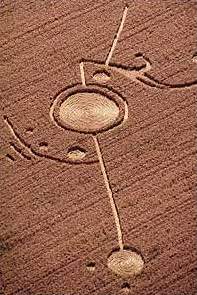
|
This crop formation was discovered in Hubbard, Ore., on July 23, 1998. The center circle is approximately 35 feet in diameter and the total width is approximately 140 feet. |
Barbara Walters has considered the subject worthy of "20/20" treatment. Cable channels from Discovery to History to Learning plan to air specials.
The vortex of publicity is dragging into the mainstream the eccentric "croppies" and the circle makers (yes, they're human) who toy with them. It's all a little funny, considering that the crop circles in "Signs" are the jumping-off point for a film that's really a rumination on faith and aliens.
"Shhhh. Don't mention that," jokes Rob Pulleyn, publisher of Lark Books in Asheville, N.C., which ordered a 30,000-copy first printing of Anderhub and Roth's paperback coffee-table book "Crop Circles," a dramatic increase from the usual first printing of 5,000.
Anyway, does it matter when "Signs" brings attention to a cast of cereologists and hoaxers who are colorful enough to inspire a movie? There are believers such as Nancy Talbott, president of BLT Research Team Inc., an organization run out of her Cambridge home that consists of "seven or eight consulting scientists and several hundred field workers around the world," she says. "Our main purpose is to carry out real scientific research, not this pseudo stuff," she adds disdainfully. It sounds convincing until she reveals that before studying crops she promoted country-music festivals.
Like Talbott, Colin Andrews, an electrical engineer from England who now lives in Branford, Conn., once thought the circles were a natural phenomenon. But today, the man Disney tapped to provide information for its "Signs" Web site doesn't mention the A-word. After all, who wants to get pegged as a UFO nut? Instead, he vaguely says, "I don't think we're looking at anything quite in the area of Mother Nature. ... The evidence I'm having to go with is that ... whatever is making the crop circles knows precisely what it's doing."
Hogwash, says Joe Nickell, 57, a senior research fellow at the Committee for the Scientific Investigation of Claims of the Paranormal in Amherst, N.Y., who has been investigating unexplained phenomena for 30 years. He easily earns his debunker tag, calling the croppies "cultlike," "pseudoscientists," and "mystery mongers." In case you don't get his point, he adds, "Some of these people are not credible."
But hoaxers such as John Lundberg can't exist without them. Lundberg's brash, London-based three-man collective, Circlemakers, calls what it does conceptual art. He and his crew see their work as a collaborative piece involving the cereologists, the media, the public, and themselves.
"The most interesting part of our work isn't particularly the pattern making," the 33-year-old says earnestly from his London home. "It's all the myths and folklores and stories that build up around the work."
That mythology compelled Pulleyn to choose "Crop Circles" as the single "wacko" book he publishes annually, he says. "There seem to be real questions: How do these things happen overnight? Who did them? I almost don't want an answer," he says, chuckling. "I also don't want it to be extraterrestrials."
Talbott discovered the subject while browsing in the international section at Harvard Square's Out of Town News about 10 years ago. She emerged from the store with a magazine filled with photos of circles. A cereologist was born.
"I went to England right away," she explains in a deep voice. The country is crop-circle ground zero. Andrews estimates that 95 percent of the world's circles appear within a 40-mile radius of Stonehenge. Could this be explained, as Nickell dryly suggests, by "a correlation between England and a lack of video arcades, bowling alleys, and other methods of amusement?"
Talbott doesn't think so. She happily launches into long, scientific-sounding explanations of the circles. She talks about plasma vortexes, energy systems that she believes swoop down and stamp fields with distinctive patterns. She mentions "massive deposits of ... pure iron" that coat plants.
Proudly and often, Talbott states that three of her studies have been published in peer-reviewed scientific journals: two in Physiologia Plantarum, a Danish journal of experimental plant biology, and one in the Journal of Scientific Exploration, a publication founded by a Stanford University professor that focuses on scientific research outside the mainstream. Like Andrews, she boasts that she's received funding from Laurence Rockefeller. She doesn't mention that Wired magazine recently described Rockefeller as a "UFOlogist."
Nickell can just as convincingly give reasons that cereologists are deluding themselves. He tells his side slowly and carefully, as if he's explaining common sense to a 2-year-old. Isn't it convenient, he asks, that the number of crop-circle sightings increases in correlation to media coverage? As for the stamps of approval from scientific journals, the research would be more credible if it were tested against a circle that doesn't have the mark of human intervention, Nickell says. "Just going out and finding something when you don't have anything to compare it to is not proof of anything."
Why not ask the Nancy Talbotts of the world, he suggests, how they explain the increasing size and complexity of recent circles? The question flusters Talbott. When prodded, she huffs that she can't explain research that has taken 10 years to compile. This is a 21/2-hour lecture, she complains. To understand it, she says, it's necessary to read BLT's information packet, which contains photographs and scientific papers. The package costs $35.
When the same question is posed to Lundberg, he doesn't need money or 21/2 hours to answer it. He talks about the spiritual fathers of present-day circle makers, Brits Doug Bower and Dave Chorley, who in 1991 admitted to making the early circles. The men were disturbed when Terrence Meaden, an English meteorologist studying crop circles, started explaining them away with the plasma-vortex theory.
"They didn't want people to think it was natural," Lundberg says of Bower and Chorley.
So the teasing began. Crop circles grew from simple circular formations to rectangles, triangles - there's even one with an intricate basket-weave design. Their sizes expanded from several feet to 15 acres. These days, Lundberg says, the goal is to "do stuff so huge, so complex, that people would question that it's man-made."
And how is it done? His www.circlemakers.org Web site, which has been logging a quarter of a million hits daily, offers a how-to guide suggesting designs and equipment (surveyor's tape, planks, garden rollers, hangers). According to his recommended method, the center is formed via an awkward one-man dance that has the circle maker pivoting on one foot while the other foot flattens the surrounding stalks. Surveyor's tape is then attached to a stick stuck into the center of the newly formed central circle. The circle makers decide on a radius length and then, keeping the tape taut, walk around the stick, leaving a slight trail with their feet. Voila! A perfectly made circle. All that's left is to stomp the formation into shape.
The hoaxers' activities caused Meaden to be "utterly disgraced and humiliated," Nickell says. As for Andrews, who worked with Meaden and coauthored the first book on the phenomenon in 1989, Nickell says, "He now has, to coin a phrase, egg on his face, shirt, jacket, trousers, spattered on his shoes."
Today, Andrews concedes that 80 percent of the English circles are man-made. Why does he remain a believer? "We have patterns as large as three-quarters of a mile across," he says plaintively. "The more impressive the geometries, the more impossible they look to be performed in a short period of time by people."
Spoken like a person who's never made a crop circle, says Lundberg. All it takes to make the huge ones, he maintains, is a team about 10 people strong. And, apparently, steel nerves.
"It's actually really stressful to do it," Lundberg says. "The more people you have in the field, the more of a nightmare it is to coordinate."
With "Signs" on the horizon, observers expect circle sightings to spike. A 25-foot design popped up in an Oregon field last month. "Every man and his dog will be going out to make one," cackles Lundberg.
But don't even think of grabbing a few drinks before hitting a field. "You have to be stone-cold sober if you're going to make them; otherwise you get wonky crop circles," says Lundberg.
Like the one depicted in the book "Crop Circles" that extends in a long, jagged line? He laughs, saying, "Maybe those are the ones that are made by aliens."
The web edition of the article on http://www.boston.com/dailyglobe2/213/living/Circular_logic+.shtml also offers to see a variety of crop circles photographs:
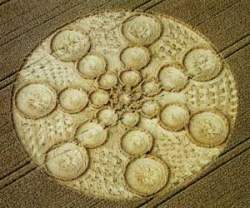 |
"The Basket" at Bishops Cannings, 8/6/99. From the book "Crop Circles: Exploring the Designs and Mysteries." AP Photo |
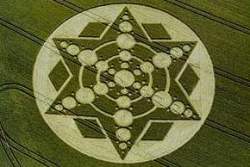 |
"Six Pointed Star," from the book "Crop Circles: Exploring the Designs and Mysteries." AP Photo |
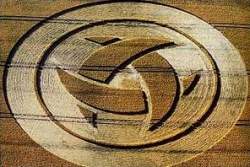 |
"The Dancing Dolphins," from the book "Crop Circles: Exploring the Designs and Mysteries." AP Photo |
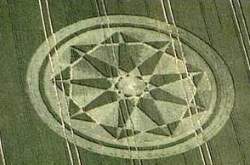 |
Crop circle from July 2001 on Milk Hill in Wiltshire County, England. Photo courtesy cropcircles.co.uk |
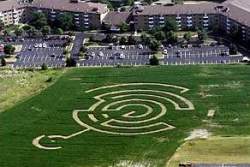 |
A crop circle in a Naperville, Ill., soybean field on July 25, 2002. The source of the circle is unknown. AP Photo |
 |
This crop formation was discovered in Hubbard, Oregon, on July 23, 1998. The center circle is approximately 35 feet in diameter and the total width is approximately 140 feet. AP Photo |